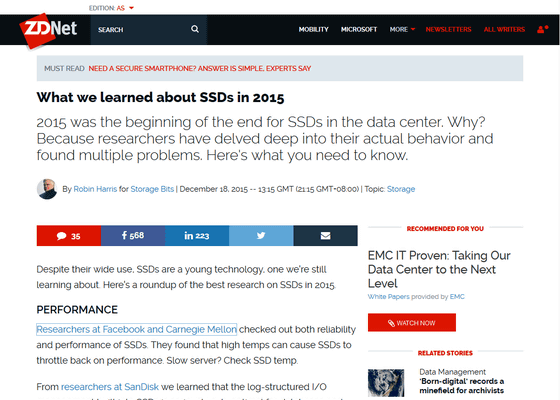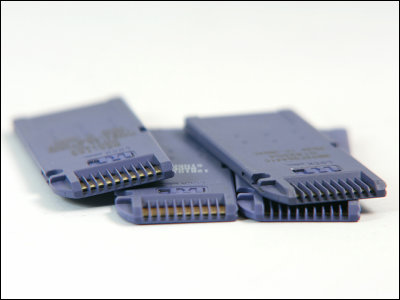What is the problem SSD has in the study that was the beginning of the end of SSD use in the data center in 2015?

ByYutaka Tsutano
ZDNet of news media is "What we learned about SSDs in 2015I will summarize what I need to know about the SSD that occurred in 2015.
What we learned about SSDs in 2015 | ZDNet
http://www.zdnet.com/article/what-we-learned-about-ssds-in-2015/

◆ Performance
Facebook and researchers at Carnegie Mellon University have confirmed both aspects of reliability and performance of SSDInvestigation, And it became clear that the performance deteriorates when the SSD becomes high temperature. Also, it is assumed that the SSD using log structuring is one step behind the optimal choice for databases and applicationsresearch resultWas released from SanDisk. It seems that most SSDs apply to this now.
Furthermore, storage using multiple flash memories "Flash arrayIt is also beginning to be a concern of people that unexpected latency (read / write delay) exists. This is a problem that when there is a light (write) that SSD can not catch up, the read (read) becomes a standby state until the light is completely finished and it becomes a large delay ".
Reliability
The paper published by Facebook also contains information on the reliability of the SSD, "There is a correlation between system write operations and SSD failures, probably due to the high power requirements for writing" The unrecoverable read error in SSD is a relatively common problem and these read errors are reported at SSD of 4.2 to 34.1% "There was discovery that" SSD is more sensitive to temperature than HDD ".
◆ Alternate Flash
Although the current SSD uses NAND flash memory, it is far from the "ideal storage medium", and it has weak points such as "dull addressing", "slow writing", and "poor durability" I will. However, the fact that NAND flash memory is very inexpensive can be used by many consumers is also a fact. Therefore, ZDNet introduces next-generation memory that may replace NAND flash memory.
· 3D Xpoint
The next-generation memory standard advocated by Intel and Micron is "3D Xpoint". It is 1000 times faster than NAND flash, the rewrite life is also 1000 times, and it has 10 times higher recording density than DRAM.
Intel and Micron begin production of new memory with processing speed 1000 times higher than conventional - GIGAZINE

· NRAM
Nantero's "NRAM" is a memory using carbon nanotubes, "faster and lower power consumption than DRAM", "infinite durability", "nonvolatile 85 degrees and durability over 1000 years" "smaller than flash It is possible to switch picoseconds in size ".
Expectation for practical application of "NRAM" using carbon nanotubes: Nihon Keizai Shimbun

Corporate Trends: Nantero Accelerates Funding Collection (1/2) - EE Times Japan Aiming for Early Practical Application of NRAM

Many of the initial SSDs were low in durability, but now many things that clear some criteria are appearing. Also,NVMeSSD equipped with the next generation standard such as the next generation will appear in the market in 2016, as the speed of CPU is becoming sluggish, it is also a fact that storage speeding has become a big help now. SSD has been pointed out many problems in 2015, but what kind of evolution will you show in 2016?
Related Posts:
in Hardware, Posted by logu_ii







